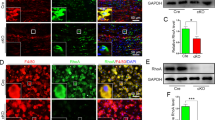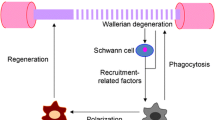Abstract
Objective
This study aimed to investigate the expression of Nogo-66 receptor (NgR) in macrophages after SCI and clarify its role in neuron regeneration.
Methods
Macrophages harvested from injured spine cord of rats were stained by double immunofluorescence labeling technique to observe the expression of NgR at histological and cellular levels. Macrophages which expressed NgR were constructed in vitro, and then the effects of NgR on macrophage phagocytosis and neuraxon regeneration in three groups (NgR-macrophages group, mock group and normal macrophages group) were studied using Western blot, micro-MTT colorimetry, and LDH assay separately.
Results
The results showed that CD68-positive macrophages in injured tissue of spine cord expressed NgR after double immunofluorescence staining on day 7 after SCI, and so did macrophages isolated and cultured from the injured spine cord. The results of Western blot showed that phagocytosis of macrophages in NgR-macrophages group was much better than that in mock group and normal macrophage group (p < 0.05). And the results of Micro-MTT colorimetry and LDH assay indicated that the capacity of neuraxon regeneration in NgR-macrophages group was significantly higher than that in the other two groups (p < 0.05).
Conclusions
The results suggested that there was NgR expressing in the infiltrated macrophages following SCI, which increased phagocytosis of the macrophages, and promoted post-SCI CNS regeneration in vitro.




Similar content being viewed by others
References
Caroni P, Schwab ME (1988) Two membrane protein fractions from rat central myelin with inhibitory properties for neurite growth and fibroblast spreading. J Cell Biol 106:1281–1288
Schwab ME, Caroni P (1988) Oligodendrocytes and CNS myelin are nonpermissive substrates for neurite growth and fibroblast spreading in vitro. J Neurosci 8:2381–2393
Fournier AE, GrandPre T, Strittmatter SM (2001) Identification of a receptor mediating Nogo-66 inhibition of axonal regeneration. Nature 409:341–346
GrandPre T, Li S, Strittmatter SM (2002) Nogo-66 receptor antagonist peptide promotes axonal regeneration. Nature 417:547–551
David Samuel, Fry ElizabethJ et al (2008) Novel roles for Nogo receptor in inflammation and disease. Trends Neurosci 5(31):221–226
Liu N, Han S, Lu PH, Xu XM (2004) Upregulation of an nex ins I, II, and V after traumatic spinal cord injury in adult rats. J Neurosci Res 77:391–401
De S, Trigueros MA, Kalyvas A, David S (2003) Phospholipase A2 plays an important role in myelin breakdown and phagocytosis during Wallerian degeneration. Mol Cell Neurosci 24:753–765
Bendszus M, Stoll G (2003) Caught in the act: in vivo mapping of macrophage infiltration in nerve injury by magnetic resonance imaging. J Neurosci 23:10892–10896
Franzen R, Schoenen J, Leprince P, Joosten E, Moonen G, Martin D (1998) Effects of macrophage transplantation in the injured adult rat spinal cord: a combined immunocytochemical and biochemical study. J Neurosci Res 51:316–327
Rapalino O, Lazarov-Spiegler O, Agranov E, Velan GJ, Yoles E, Fraidakis M, Solomon A, Gepstein R, Katz A, Belkin M, Hadani M, Schwartz M (1998) Implantation of stimulated homologous macrophages results in partial recovery of paraplegic rats. Nat Med 4:814–821
Schwartz M, Lazarov-Spiegler O, Rapalino O, Agranov I, Velan G, Hadani M (1999) Potential repair of rat spinal cord injuries using stimulated homologous macrophages. Neurosurgery 44:1041–1045 (discussion 1045–1046)
Batchelor PE, Liberatore GT, Wong JY, Porritt MJ, Frerichs F, Donnan GA, Howells DW (1999) Activated macrophages and microglia induce dopaminergic sprouting in the injured striatum and express brain-derived neurotrophic factor and glial cell line-derived neurotrophic factor. J Neurosci 19:1708–1716
Blight AR (1992) Macrophages and inflammatory damage in spinal cord injury. J Neurotrauma 9(Suppl. 1):S83–S91
Minagar A, Shapshak P, Fujimura R, Ownby R, Heyes M, Eisdorfer C (2002) The role of macrophage/microglia and astrocytes in the pathogenesis of three neurologic disorders: HIV-associated dementia, Alzheimer disease, and multiple sclerosis. J Neurol Sci 202:13
Popovich PG (2000) Immunological regulation of neuronal degeneration and regeneration in the injured spinal cord. Prog Brain Res 128:43–58
Stoll G, Jander S (1999) The role of microglia and macrophages in the pathophysiology of the CNS. Prog Neurobiol 58:233–247
Kiefer R, Kieseier BC, Stoll G, Hartung HP (2001) The role of macrophages in immune-mediated damage to the peripheral nervous system. Prog Neurobiol 64:109–127
Fitch MT, Silver J (1997) Activated macrophages and the blood–brain barrier: inflammation after CNS injury leads to increases in putative inhibitory molecules. Exp Neurol 148:587–603
Mckerracher L, David S (2004) Easing the brakes on spinal cord repair. Nat Med 10:1052–1053
Lazarov-Spiegler O, Solomon AS, Schwartz M (1998) Peripheral nerve stimulated macrophages simulate a peripheral nerve-like regenerative response in rat transected optic nerve. Glia 24:329–337
Prewitt CM, Niesman IR, Kane CJ, Houle JD (1997) Activated macrophage/microglial cells can promote the regeneration of sensory axons into the injured spinal cord. Exp Neurol 148:433–443
David S, Lacroix S (2003) Molecular approaches to spinal cord repair. Annu Rev Neurosci 26:411–440
Acknowledgments
Supported by National Natural Science Foundation of China (No. 30872612).
Author information
Authors and Affiliations
Corresponding author
Rights and permissions
About this article
Cite this article
Zhu, Z., Ni, B., Yin, G. et al. NgR expression in macrophages promotes nerve regeneration after spinal cord injury in rats. Arch Orthop Trauma Surg 130, 945–951 (2010). https://doi.org/10.1007/s00402-010-1065-8
Received:
Published:
Issue Date:
DOI: https://doi.org/10.1007/s00402-010-1065-8




